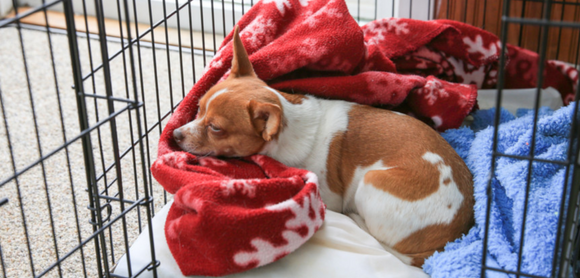What are the benefits of crate training?
Using a crate isn’t just a great way to give your dog a comfortable den of their own where they can relax, it can also offer plenty of other benefits, including:
- Keeping your dog safe while travelling
- Confining your dog after surgery
- Provides a safe space for your dog to spend time unsupervised
- Helping your dog settle into a new environment
How do I choose the right crate?
A crate needs to be large enough for your dog to stand up at their full height, turn around, and stretch out fully when lying down. If you’re buying a crate for your puppy, you may need to replace this with a larger size as your puppy grows, or choose a crate to suit the average size of their breed once fully grown. Depending on when and where you’re planning to use the crate, you can find a range of models, including those that pack down for easy transport. Choose a design you can easily set up and carry.
Where should I put my dog’s crate?
The best place for your dog’s crate is a quiet part of the house, where they’re unlikely to be disturbed. Avoid busy areas like hallways, kitchens, or anywhere with many passing people. Your dog’s crate should be somewhere they feel comfortable spending time away from the hustle and bustle of everyday life.
What should I put inside the crate?
Make your dog’s crate as inviting as possible by adding a bed and blanket. A non-spill water bowl is also essential, so your dog can have a drink whenever they like. You can also place some of your dog’s toys or treats inside. Use a blanket to cover the sides to exclude draughts and reduce sounds from outside, if necessary.
How to crate train a puppy or dog: the basics
Whether you’re crate training an older dog or puppy, the process should be gradual. Take it slow, and only progress to the next step once your dog is entirely confident. Some dogs will quickly become comfortable with their crate while others will need a little more time. There is no hard and fast crate training schedule, for a puppy or an older dog; the training timeline will all depend on the individual, but these are the basic steps you’ll need to follow:
- Introduce the crate in a fun way
- Teach your dog to go in and out of their crate
- Closing the door
- Stepping away from the crate
- Leaving the room
Step 1: Introduce the crate in a fun way
Once your dog’s crate is in position, the first step is to allow your dog to investigate it in their own time. Secure the door so that it stays open and won’t swing shut whilst your dog is exploring. Your dog might sniff around the crate, pop their head inside, or even go all the way in! Have some treats ready so if they do go inside you can reward them with food and verbal praise.
At this point, your dog needs to feel comfortable and confident that they can come out of the crate quickly and easily, so they feel safe at all times. This will help build their confidence and create positive associations with being inside the crate.
Step 2: Teach your dog to go in and out of their crate
Once your dog is confident and relaxed around their crate, you can start actively encouraging them to go inside. Choose a high-value food reward, and drop a few treats inside the crate. Your dog should happily move inside the crate. At this point, drop more treats into the crate but try to do this while your dog’s attention is away from you. This will help place their focus on the crate being the source of the treats, not you!
If your dog is reluctant, try dropping the treats in the doorway and wait until they’re fully confident eating the treats from this position. Then move the treats slightly further inside. If your dog moves out of the crate, don’t call them back over but just wait for them to return. When they do, start dropping treats again. This process helps your dog to start settling in their crate and associating it with good things — like food!
Practise at different times of day and gradually reduce the number of treats as your dog naturally chooses their crate as somewhere to go to relax. Don’t make too much fuss when you see your dog going into their crate, but gently tell them how good they are. As your dog spends more time in the crate you can drop in a treat occasionally.
Step 3: Closing the door
Once your dog is happy spending time in their crate with the door open, you can start teaching them that the door closes. Take this step slowly and steadily, as you want to maintain the confidence from the previous steps.
To start with, gently close the door slightly while your dog is inside the crate. Don’t shut it fully yet, in case your dog wants to get out. Repeat this a few times before securing the door for just one second, before opening it again.
Gradually build up the amount of time your dog spends inside the crate with the door closed. Other crate training tips include offering a long-lasting chew for them to enjoy while they’re inside, or dropping in some treats when you see your dog relaxing.
Whenever you’re not training, remember to open the door once more, so your dog can come and go as they please.
If at any point your dog shows any signs of worry, like whining or scrabbling to get out, go back to a previous step and work on getting them comfortable again. Then gently move back to this step and see how they get on.
Step 4: Stepping away from the crate
Once your dog starts to relax inside the crate with the door closed, you can start to go about your normal day-to-day activities while they can still see you. This helps your dog learn that you can be active around the house while they stay in their crate. Keep these sessions short to begin with, and stay in the same room as you gradually build up the amount of time you leave your dog in their crate.
Step 5: Leaving the room
Many dogs will happily stay in their crate while you’re in the room, but may start to worry when you leave. By now, your dog should understand that their crate is a good place to be. This step reinforces that their crate is still a good thing, even when you’re not with them.
Start by giving your dog a long-lasting chew, food-releasing toy, or their meal, and then close the crate door. Move towards the door and see how your dog reacts. If they appear calm you can leave the room briefly before returning and carrying on with your activities. If your dog still seems relaxed, you can throw a treat into the crate and then leave the room again. Slowly build up the amount of time you leave the room, always making sure your dog has a tasty treat to keep them occupied. This helps your dog learn that they don’t need you to be in the same room with them all the time to enjoy hanging out in their crate.


